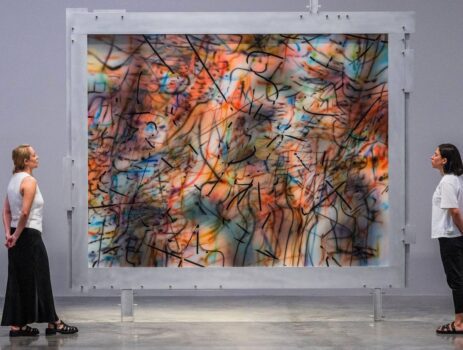Julie Mehretu’s Famous Paintings
Julie Mehretu’s canvases are like maps of impossible cities , places that exist somewhere between history and imagination, order and chaos, personal memory and global narrative. With her monumental scale, layered compositions, and dizzying interplay of marks, she has carved a unique space in contemporary art, one that draws viewers in to wander through visual worlds at once overwhelming and deeply intimate.
This article dives deep into her life and career: her most famous paintings, the prices her works command, what she’s known for, how she creates her paintings, how many works she has produced, her signature style, the materials she uses, and where her art can be found today.
Who is Julie Mehretu?
Born in 1970 in Addis Ababa, Ethiopia, Julie Mehretu’s early life was shaped by political unrest. Her father, a professor, and her mother, a teacher, moved the family to the United States in 1977 after Ethiopia’s political climate became volatile under the Derg regime. They settled in Michigan, where Mehretu grew up navigating multiple cultural identities , a personal experience that would later echo in the layered, transnational feel of her paintings.
She studied at Kalamazoo College, earning her BA in 1992, and later received a Master of Fine Arts degree from the Rhode Island School of Design in 1997. Her breakthrough came in the early 2000s when her massive paintings, filled with architectural blueprints, calligraphic marks, and abstract gestures, began to draw international attention.
What Was Julie Mehretu Known For?
Julie Mehretu is best known for her monumental, multi-layered abstract paintings that often incorporate elements of architectural diagrams, historical maps, and topographical references. Her works are visual records of movement, migration, history, and political unrest , but instead of telling these stories in a literal way, she uses abstraction to evoke the experience of living through them.
Key aspects she’s known for:
Large scale: Some works are over 20 feet wide, enveloping viewers.
Layered technique: She builds paintings through multiple stages of drawing, erasing, painting, and glazing.
Political and social undertones: Many pieces respond to global events , wars, revolutions, migrations, climate crises.
Architectural influence: She often integrates structural plans and city grids into her abstract fields.
Energetic mark-making: Small, gestural marks swarm across the canvas like crowds, storms, or constellations.
Julie Mehretu’s Famous Paintings
While Mehretu has created dozens of celebrated works, a few stand out as particularly iconic in her career:
3.1. Stadia II (2004)
Perhaps her best-known work, Stadia II is a monumental painting that looks like a hybrid between an Olympic stadium and a political rally. It’s filled with swirling marks, banners, and abstracted symbols. The piece is part of a trilogy (Stadia I, II, III) that explores the spectacle of mass gatherings , from sports to protests , and how such spaces can be charged with both hope and violence.
3.2. Mural (2009)
Commissioned by Goldman Sachs for their New York headquarters, this 80-foot-long painting is one of the largest corporate art commissions of the 21st century. It took Mehretu nearly a year to complete and contains layers of imagery referencing world history, architecture, and abstraction.
3.3. Grey Area Series (2009)
A set of six paintings created during a residency in Berlin, exploring the city’s history and transformation. These works are quieter than some of her earlier pieces, using muted colors to evoke the palimpsest-like layering of time.
3.4. Howl, eon (I, II, III) (2017)
These large works were part of her shift toward a more gestural, less architectural abstraction, incorporating spray paint, smudges, and looser mark-making.
3.5. Transcending: The New International (2003)
Installed at the Detroit Institute of Arts, this painting is a commentary on global migration, trade, and communication in the 21st century.
How Much Do Julie Mehretu’s Paintings Cost?
Julie Mehretu is one of the most commercially successful living female artists. Her paintings have sold for millions at auction:
In 2019, her work Black Ground (Deep Light) sold for $5.6 million at Sotheby’s , a record for the artist at the time.
Large-scale paintings typically sell for $1.5–$6 million depending on size, period, and provenance.
Smaller works on paper can range from $50,000 to $300,000.
The high value reflects her status in the art world, institutional recognition, and the labor-intensive process behind each piece.
How Does Julie Mehretu Make Her Paintings?
Mehretu’s process is layered, architectural, and highly planned , yet also open to improvisation.
Step-by-step overview:
Research & imagery sourcing
She gathers photographs, maps, news clippings, and architectural blueprints relevant to the subject she wants to explore. These might be images of protest sites, stadiums, ruined cities, or climate-affected landscapes.Digital collage
Often, she composes a digital composite of architectural lines and imagery that becomes the foundation for the painting.Under-drawing
She begins by projecting architectural outlines onto the canvas and tracing them in graphite or ink.First paint layers
She applies thin acrylic washes, spray paint, and airbrushed gradients to build atmospheric depth.Mark-making
Using brushes, pens, and even erasers, she makes hundreds (sometimes thousands) of gestural marks , lines, dots, dashes , that swarm and scatter across the surface.Glazing
Transparent layers of paint or resin are added to create depth, then worked over again with new marks.Final composition
The painting evolves over months, sometimes years, with marks erased, overpainted, or shifted until a balance emerges.
The result is a dense, spatially complex work that feels at once meticulously constructed and explosively alive.
How Many Paintings Does Julie Mehretu Have?
There is no exact public count of Julie Mehretu’s works, as her practice spans paintings, works on paper, and prints over more than 25 years. However:
Major institutions collectively hold over 80 of her works.
She has completed dozens of large-scale paintings for exhibitions and commissions.
When including her smaller works, editions, and drawings, estimates suggest well over 200 unique works exist.
Given the scale and complexity of her process, she produces relatively few works per year , often fewer than ten.
What Art Style Is Julie Mehretu Associated With?
Julie Mehretu’s style is often described as:
Abstract , but with figurative and architectural references embedded.
Abstract cartography , mapping non-physical spaces.
Geopolitical abstraction , connecting abstraction to political and historical realities.
Postmodern layering , incorporating multiple historical and cultural references into a single field.
Art historians have linked her to movements like Abstract Expressionism (for her energetic gestures), Futurism (for the sense of movement), and Constructivism (for structural elements). Yet, she’s carved out a unique visual language that resists being boxed into a single category.
What Materials Does Julie Mehretu Use?
Mehretu’s materials are a mix of traditional and contemporary media:
Acrylic paint , often in thin washes for translucent color fields.
Ink , for precise linework and drawing.
Graphite and colored pencil , for under-drawings and fine marks.
Spray paint , for atmospheric effects and quick gestures.
Digital projections , to transfer complex architectural lines onto the canvas.
Canvas , typically large, custom-stretched.
Resin and varnish , for glazing and depth.
Where Are Julie Mehretu’s Paintings Located?
Mehretu’s works are held by major museums, private collections, and public institutions worldwide. Some notable locations:
The Museum of Modern Art (MoMA), New York , several works in the permanent collection.
Whitney Museum of American Art, New York , hosted a major mid-career retrospective in 2021.
The Art Institute of Chicago , holds Stadia II.
San Francisco Museum of Modern Art (SFMOMA) , owns large works from different periods.
National Gallery of Art, Washington D.C.
Metropolitan Museum of Art, New York.
Tate Modern, London.
Detroit Institute of Arts , Transcending: The New International.
Goldman Sachs Headquarters, New York , Mural.
Her paintings also appear in private collections of prominent art patrons around the world.
Julie Mehretu’s Legacy and Influence
Julie Mehretu’s work speaks to the complexity of our interconnected world. She has influenced a generation of artists who use abstraction not as an escape from reality but as a tool to grapple with it. Her layered maps of time and space encourage viewers to think about the forces , political, cultural, environmental , that shape human experience.
Her career has broken significant ground for women artists of color in the global art market, and she continues to redefine what large-scale painting can be in the 21st century.
Julie Mehretu’s paintings are not simply pictures , they are environments. Standing before one of her massive works is like standing at the edge of a storm, or in the center of a city you’ve never visited but somehow recognize.
From her iconic Stadia II to the monumental Mural at Goldman Sachs, from multi-million-dollar auction sales to museum retrospectives, Mehretu has cemented her place as one of the most significant artists of our time.
Her art is proof that abstraction can be both intensely personal and globally resonant , a language for mapping the unmappable. image/ britannica




